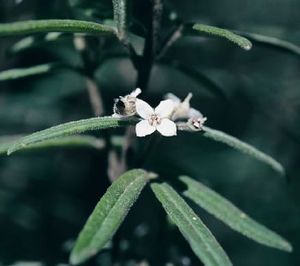Murphy's zieria facts for kids
Quick facts for kids Murphy's zieria |
|
|---|---|
 |
|
| Conservation status | |
| Scientific classification | |
| Genus: |
Zieria
|
| Species: |
murphyi
|
Murphy's zieria (scientific name: Zieria murphyi) is a special plant found only in New South Wales, Australia. It belongs to the citrus family called Rutaceae. This means it's related to plants like oranges and lemons!
This plant is a slim shrub with pretty white or pale pink flowers. Each flower has four petals and four stamens (the parts that make pollen). You can usually find it growing in cozy, protected spots in open forests, often near the bottom of rocky cliffs.
Contents
What Murphy's Zieria Looks Like
Murphy's zieria is a slender shrub that usually grows about 1 to 2 meters (3 to 7 feet) tall. Its branches are smooth, but when they are young, they feel soft and velvety.
Leaves and Flowers
The leaves of this plant can be simple, meaning just one leaflet. Or, they can be made up of three smaller leaflets. These leaflets are long and narrow, like a spearhead. The middle leaflet is usually about 30 to 49 millimeters (1 to 2 inches) long and 3 to 10 millimeters (0.1 to 0.4 inches) wide.
The top side of the leaves is a dark green and feels soft because of tiny hairs. The bottom side is a lighter green and has velvety, star-shaped hairs.
The flowers are white to pale pink. They grow in small groups of three to nine flowers where the leaves meet the stem (this spot is called a leaf axil). The flowers are smaller than the leaves. Each flower has four triangular sepals (small leaf-like parts under the petals). The four petals are about 4 to 6 millimeters (0.16 to 0.24 inches) long and are also covered with soft hairs.
When it Flowers and Fruits
Murphy's zieria mostly flowers in August and September. After the flowers bloom, the plant produces fruits in the summer. These fruits are smooth capsules (a type of dry fruit that opens to release seeds) and are also covered with soft hairs.
How Murphy's Zieria Got its Name
This plant was first officially described in 1940 by a scientist named William Blakely. He published his description in a magazine called The Australian Naturalist.
The very first plant specimen used to describe Zieria murphyi was collected by "Edward Murphy of Wingello." He found it near a place called Penrose. The second part of the plant's scientific name, murphyi, was chosen to honor Edward Murphy, who collected that important first sample.
Where Murphy's Zieria Lives
Murphy's zieria grows in open forests. It prefers sheltered spots, often found right below sandstone cliffs. You can find this special plant in a few specific areas in New South Wales. These places include near Mount Tomah, Penrose, and Bundanoon.
Protecting Murphy's Zieria
Murphy's zieria is considered a "vulnerable" plant. This means it's at risk of disappearing if we don't protect it. Both the New South Wales Threatened Species Conservation Act and the Australian Government's Environment Protection and Biodiversity Conservation Act 1999 (EPBC) Act list it as vulnerable.
The biggest groups of these plants are found in the Blue Mountains National Park and Morton National Park. However, even in these parks, there are fewer than 1,000 individual plants. Other groups of Murphy's zieria are much smaller.
This plant can only grow new plants from its seeds. This makes it very sensitive to frequent bushfires. If fires happen too often, the plants don't have enough time to grow and produce new seeds, which threatens their survival.


